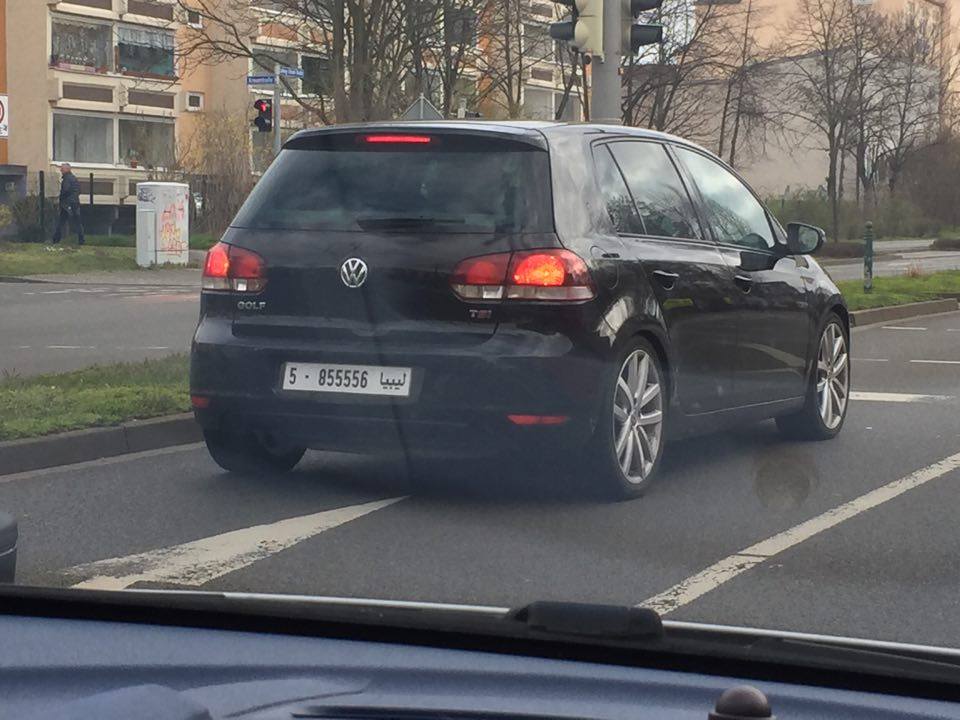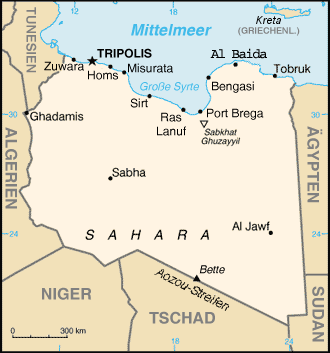|
Tarhuna
Tarhuna (; ar, ترهونة), also Tarhoona or Tarhunah, is a Libyan town to the southeast of Tripoli, in the Murqub District. The city derives its name from that of its pre- Roman-era inhabitants, a Berber tribe. The city was known as al-Boirat during the 19th through mid 20th century but assumed its current name after Libyan independence. The Tarhuna District, including the city of Msallata, had an urban population of about 296,000 (est. 2003). The population in Tarhuna proper was calculated to be 13,264 in 2011. Geographical boundaries: from the "Valley of the famm Molgha" west to "Burkaat Oueny" eastward. Then from the "Suq al Juma (Al-msab`ha)" north, " Al-mzawgha and Marghna" south. History In the city centre of Tarhuna, just opposite the Tarhuna mosque, there is a memorial to Ali Swidan Alhatmy, who was a hero in the 18 June 1915 Battle of El-Shqiga against the Italians. He was captured in 1922 and hanged by the Italians in the town square. The population generally ... [...More Info...] [...Related Items...] OR: [Wikipedia] [Google] [Baidu] |
Tarhuna Wa Msalata District
Tarhuna wa Msalata ( Tarhuna and Msallata) was a district of Libya until 2007."شعبية ترهونة و مسلاتة" ("Districts of Libya:Tarhuna Wa Msalata") Website of the General People's Committee of Libya, in Arabic, from dated 15 October 2006 Between 1988 and 1995 there existed the Tarhuna District, which became Tarhuna wa Msalata between 2001 and 2007. It consisted of twenty-six [...More Info...] [...Related Items...] OR: [Wikipedia] [Google] [Baidu] |
Districts Of Libya
In Libya there are currently 106 districts, second level administrative subdivisions known in Arabic as ''baladiyat'' (singular ''baladiyah''). The number has varied since 2013 between 99 and 108. The first level administrative divisions in Libya are currently the governorates (''muhafazat''), which have yet to be formally deliniated, but which were originally tripartite as: Tripolitania in the northwest, Cyrenaica in the east, and Fezzan in the southwest; and later divided into ten governorates. Prior to 2013 there were twenty-two first level administrative subdivisions known by the term ''shabiyah'' (Arabic singular ''šaʿbiyya'', plural ''šaʿbiyyāt'') which constituted the districts of Libya. In the 1990s the shabiyat had replaced an older baladiyat system. Historically the area of Libya was considered three provinces (or states), Tripolitania in the northwest, Cyrenaica in the east, and Fezzan in the southwest. It was the conquest by Italy in the Italo-Turkish War ... [...More Info...] [...Related Items...] OR: [Wikipedia] [Google] [Baidu] |
Tarhuna District
Tarhunah Municipality ( ar, ترهونة) is one of the former municipality ( baladiyat) of Libya from 1983 to 1995. It is in the north of the country, in the position later (2001-2007) occupied by Tarhuna Wa Msalata District. Tarhunah was brought to international attention in the 1990s, when it was believed that an underground chemical weapons facility was being built there, following the discovery of a previous smaller above-ground facility at Rabta (Algeria?). See also * Tarhuna Wa Msalata District Tarhuna wa Msalata ( Tarhuna and Msallata) was a district of Libya until 2007. [...More Info...] [...Related Items...] OR: [Wikipedia] [Google] [Baidu] |
Msallata
Msallata (also Al Qasabat, Cussabat and El-Gusbát) is a town in the northwestern part of Libya, in the Murqub District. It has a population of nearly 24,000, and was historically a center of Islamic studies. It is also known for olive tree farming and olive oil production. The Tripolian Republic was announced in Msallata on 16 November 1918 which was the first republic in the Arab world. Along with the city of Tarhuna, it gave its name to the former Libyan district of Tarhuna wa Msalata. Etymology There has not been any research on the etymology of the name ''Msallata'', but there is some speculation as to its origins. One theory is that the name comes from the plural of the Arabic word for obelisk which is , because the city is the home of 22 tall buildings called qasaba. Others speculate that the name comes from the Arabic word ''salt'' (scrubbing), which also has the more specific meaning of 'scrubbing olive from its tree', with the ''M'' at the beginning being a variant of th ... [...More Info...] [...Related Items...] OR: [Wikipedia] [Google] [Baidu] |
Murqub District
Murqub ( ar, المرقب ''Al Murqub''), sometimes spelt ''Al Murgub'' or ''Al Marqab'' or ''al-Morqib'', is one of the districts of Libya. The main city and capital is Khoms. The widely visited UNESCO World Heritage Site of Leptis Magna is also located in the district. In the north, Murqub has a shoreline on the Mediterranean Sea. On land, it borders Misrata to the east and south, Tripoli to the northwest and Jabal al Gharbi to the west. Per the census of 2012, the total population in the region was 157,747 with 150,353 Libyans. The average size of the household in the country was 6.9, while the average household size of non-Libyans being 3.7. There were totally 22,713 households in the district, with 20,907 Libyan ones. The population density of the district was 1.86 persons per sq. km. In 2007 the district was enlarged to include twenty-six Basic People's Congresses (townships) of what had been the Tarhuna wa Msalata District. Geography In the north, Murqub has a shoreli ... [...More Info...] [...Related Items...] OR: [Wikipedia] [Google] [Baidu] |
Second Libyan Civil War
{{Infobox military conflict , conflict = Second Libyan Civil War , partof = the Arab Winter, Libyan Crisis (2011–present), Libyan Crisis, Iran–Saudi Arabia proxy conflict, War on terror, and Qatar–Saudi Arabia diplomatic conflict , image = Libyan Civil War.svg , image_size = 400px , caption = Military situation in Libya on 11 June 2020{{legend, #ebc0b3, Under the control of the House of Representatives (Libya), House of Representatives and the Libyan National Army{{legend, #cae7c4, Under the control of the Government of National Accord (GNA) and different militias forming the Libya Shield Force{{legend, #afc6e9, Controlled by local forces (For a more detailed map, see Template:Libyan Civil War detailed map, military situation in the Libyan Civil War) , date = 16 May 2014 – 23 October 2020({{Age in months, weeks and days, year1=2014, month1=05, day1=16, year2=2020, month2=10, day2=23) , place = ... [...More Info...] [...Related Items...] OR: [Wikipedia] [Google] [Baidu] |
Libya In The Roman Era
The area of North Africa which has been known as Libya since 1911 was under Roman domination between 146 BC and 672 AD (even if in the meantime it was taken by the Vandals in 430 AD, and then recaptured by the Byzantines). The Latin name ''Libya'' at the time referred to the continent of Africa in general. What is now coastal Libya was known as Tripolitania and Pentapolis, divided between the Africa province in the west, and Crete and Cyrenaica in the east. In 296 AD, the Emperor Diocletian separated the administration of Crete from Cyrenaica and in the latter formed the new provinces of "Upper Libya" and "Lower Libya", using the term ''Libya'' as a political state for the first time in history. History After the final conquest and destruction of Carthage in 146 BC, northwestern Africa went under Roman rule and, shortly thereafter, the coastal area of what is now western Libya was established as a province under the name of Tripolitania with Leptis Magna capital and the major tr ... [...More Info...] [...Related Items...] OR: [Wikipedia] [Google] [Baidu] |
Libyan National Army
The Libyan National Army (LNA; ar, الجيش الوطني الليبي, ''al-jaysh al-waṭaniyy al-Lībii'') is a component of Libya's military forces which were nominally a unified national force under the command of Field Marshal Khalifa Haftar when he was nominated to the role on 2 March 2015 by the House of Representatives, consisting at the time of a ground force, an air force and a navy. In 2014, LNA launched Operation Dignity, a military campaign against the General National Congress and armed militias and Islamist militant organizations. When the internationally recognised Government of National Accord (GNA) was established in Tripoli, part of the Libyan military forces were named the Libyan Army to contrast with the other part that retained the LNA identity. In the ongoing Civil War, the LNA is loyal to that part of the Libyan House of Representatives that meets in Tobruk, internationally recognised until October 2015. It fights against the Shura Council of Benghazi ... [...More Info...] [...Related Items...] OR: [Wikipedia] [Google] [Baidu] |
Tripolitania
Tripolitania ( ar, طرابلس '; ber, Ṭrables, script=Latn; from Vulgar Latin: , from la, Regio Tripolitana, from grc-gre, Τριπολιτάνια), historically known as the Tripoli region, is a historic region and former province of Libya. The region had been settled since antiquity, first coming to prominence as part of the Carthaginian empire. Following the defeat of Carthage in the Punic Wars, Ancient Rome organized the region (along with what is now modern day Tunisia and eastern Algeria), into a province known as Africa, and placed it under the administration of a proconsul. During the Diocletian reforms of the late 3rd century, all of North Africa was placed into the newly created Diocese of Africa, of which Tripolitania was a constituent province. After the Fall of the Western Roman Empire in the 5th century, Tripolitania changed hands between the Vandals and the Byzantine Empire, until it was taken during the Muslim conquest of the Maghreb in the 8th centu ... [...More Info...] [...Related Items...] OR: [Wikipedia] [Google] [Baidu] |
Vehicle Registration Plates Of Libya
Libya requires its residents to register their motor vehicles and display vehicle registration plates. Current plates are European standard 520 mm × 110 mm. Current Series Libya's current series of license plates entered circulation in 2013, after Libyan Revolution and the overthrow of Gaddafi. Numbers on license plates are in Latin Alphabet, and all plates carry the Arabic text ليبيا meaning ''Libya'', in Naskh Script, either on the right hand side or the right top corner. Private Vehicles Private vehicle license plates are black on white and follow the format ''# - 1 to 999999 The First number (#), a 1 or 2 digit number consists of a code corresponding to Municipality in Libya. This number is separated by a dash from the registration code, which can be 1 to 6 digits. In the city of Tripoli, due to its larger population, 7-digit registration codes are also issued. Foreigner-owned Private Vehicles Foreigner-owned Private vehicle license plates are black on w ... [...More Info...] [...Related Items...] OR: [Wikipedia] [Google] [Baidu] |
List Of Cities In Libya ...
This is a list of the 100 largest populated places in Libya. Some places in the list could be considered suburbs or neighborhoods of some large cities in the list, so this list is not definitive. ''Source:Amraja M. el Khajkhaj, "Noumou al Mudon as Sagheera fi Libia", Dar as Saqia, Benghazi-2008, pp. 118-123.'' See also * Transliteration of Libyan placenames *List of metropolitan areas in Africa *List of largest cities in the Arab world References External links * {{List of cities in the Middle East Libya, List of cities in Libya Cities A city is a human settlement of notable size.Goodall, B. (1987) ''The Penguin Dictionary of Human Geography''. London: Penguin.Kuper, A. and Kuper, J., eds (1996) ''The Social Science Encyclopedia''. 2nd edition. London: Routledge. It can be def ... [...More Info...] [...Related Items...] OR: [Wikipedia] [Google] [Baidu] |
2020 In Libya
Events in Libya in 2020 Incumbents * President: Fayez al-Sarraj * Prime Minister: Abdullah al-Thani Events January * January 2 **The Grand National Assembly of Turkey passes a one-year mandate in order to deploy troops to Libya. *January 5 **Turkey starts to deploy troops in Libya. * January 6 **Turkey sends troops and electronic warfare tools to Libya to defend the existing government therehttps://www.bbc.com/news/world-africa-51003034 Libya conflict: Turkey sends troops to shore up UN-backed government,6 January 2020, bbc.Turkey sends troops and electronic warfare tools to Libya in challenge to rogue general and UAE Sophisticated radar-jamming system meant to render precision we ... [...More Info...] [...Related Items...] OR: [Wikipedia] [Google] [Baidu] |

.jpg)



